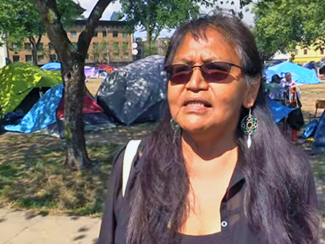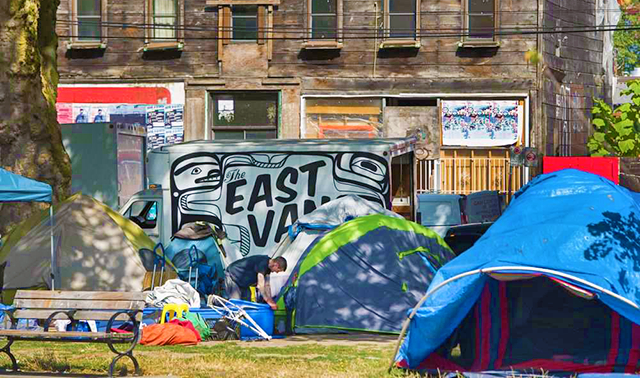MEAN STREETS
Homelessness in Vancouver grows and spirals downward

Community activist Erica Grant
THE DOWNTOWN EASTSIDE OF VANCOUVER MAY NOT BE HELL ON EARTH. But it keeps edging closer to it.
“I’ve lost so many friends down here, so many family members,” says Erica Grant, a local resident who lives in a single-room occupancy hotel. “It feels like we’re in a war zone.”
The DTES (Downtown Eastside) was always “rough”, with a lot of homelessness and drug use—but not so “in your face.” Not anymore says community advocate Julie Louise Chapman.
“The last two years have been the worst changes, I think,” says Julie. “A lot of homelessness, a lot of drug use out in the open. You never used to see that at all, not to that degree.”
Vancouver’s homeless population shot up to 2,200 over the last four years—an increase of close to 25 percent.
Increased overdoses and deaths from opioids now stretch already inadequate healthcare and social support services to the breaking point.
As rough as it was, DTES folks used to have their own “code” that they lived by. Not any more says Karen Ward, a local drug policy advocate.
“It used to be, you don’t rip off your friends. You don’t mess up the place where you live. You don’t hurt or take advantage of people who are weaker...there was a code. You look out for each other—it’s falling apart.” Living conditions on the Eastside no longer leave any room for community.

Homeless forced into shelters
It costs a lot to live in Vancouver. A recent study estimated that a worker would need to earn around $35 an hour to be able to afford a two-bedroom apartment in Vancouver. A lot of homelessness is the inevitable result.
The most visible example of the impact of the Vancouver housing crisis is the tent city in Oppenheimer Park in the DTES. It is estimated that at least 100 people live in the tent city. The city is determined to evict them all. Some into public housing, but 30 or 40 into homeless shelters.
Shelters usually prohibit the use of drugs. This makes them the last place anyone struggling with drug addiction wants to go. Moreover, the Carnegie Community Action Project points out that easy access to support services and the community spirit in the tent city makes it a safer place to stay than any other option.
Drug overdoses
Vancouver is also in the grip of a drug crisis: there were over 360 drug overdose deaths in the city in 2018—about one every day. DTSE is ground zero for this crisis.
“So, with people not able to access a clean drug supply, you don’t know what you’re getting,” explains Ryan Vena, founder of Street Saviours, an organization helping to treat overdose victims. “It’s not safe anymore.”
The opioid crisis has also had a devastating impact on local residents’ mental health and wellbeing. According to Dr. Bill MacEwan, head of psychiatry at St. Paul’s Hospital, fully 75 percent of DTSE residents have suffered from a major mental health illness.
Promises made, promises broken
The worsening conditions of life in the DTES neighbourhood are not inevitable. They have been produced by policy failures at all levels of government.
In 2000, federal, provincial, and city governments reached the Vancouver Agreement, which was supposed to expand housing and improve social services within a decade. But the terms of the Agreement were never implemented because the Harper Conservatives abandoned it when they came to power in 2006.
Nearly twenty years on, the City of Vancouver still can’t provide suitable housing for one or two hundred homeless people camping in Oppenheimer Park, never mind the more than 2,000 plus homeless officially recorded throughout the city.
There is no political will to face up to the underlying causes of any of it. Not with the need for decent public housing for all; and not with the need for affordable and accessible healthcare and mental health services.
Without that political will, life on the streets of the Downtown Eastside of Vancouver will only grow meaner and be a painful reminder of how far we have to go to become “a just society.”
- 30 -













Add new comment